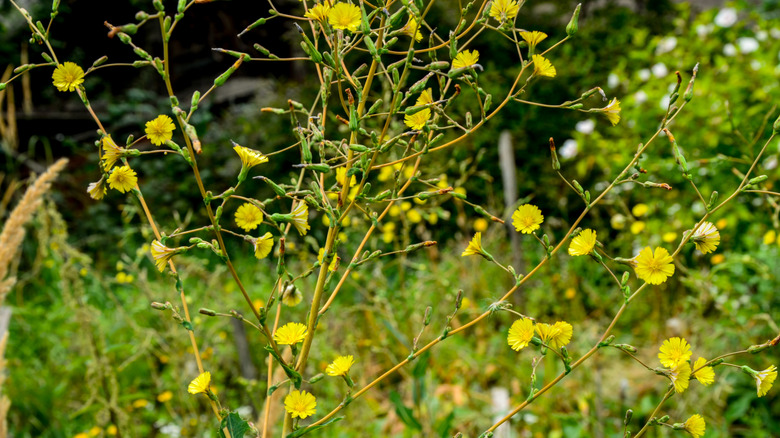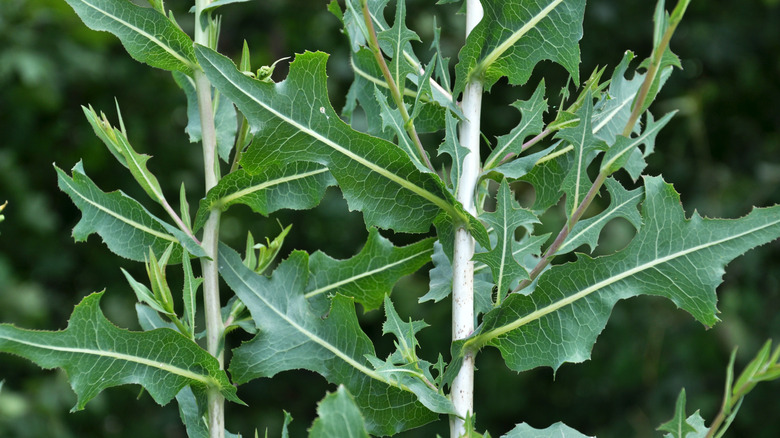How To Get Rid Of Prickly Lettuce Weeds Before They Take Over Your Yard
We may receive a commission on purchases made from links.
Bare feet in lush summer grass are a seasonal pleasure, but your enjoyable stroll can quickly become unpleasant when you tread upon a bit of prickly lettuce (Lactuca serriola). This European plant, which has spread across the United States over the last century, is riddled with spines on its leaves and stems, making it unpleasant to touch. Once prickly lettuce blooms, it's easy to mistake this invasive weed for flowers. But say they make their way into your yard — what can you do?
Well, you can rest easy, as prickly lettuce isn't terribly difficult to remove. That said, you need to follow tried-and-true methods, as this species can't usually be controlled with herbicides. Save yourself some dollars and toxins by rolling up your sleeves, donning some gloves, and digging into the dirt. Pulling up these plants by their roots or even tilling when they're young is best practice once these spiny leaves appear.
How to hand-pull prickly lettuce weeds
Despite prickly lettuce's impressive taproot, it spreads through its seeds rather than through a root system. It's a biennial, meaning that it takes two years to mature and bloom. In its first fall, it forms a small rosette that hides well among other plants. At this stage of growth, it's small and leafy with no stalk. Look for spiny leaves with deep lobes on their edges that grow directly from the ground in a "head." Before it blooms, prickly lettuce's rosettes can resemble dandelion leaves. Once you spot them, pull them out with a trowel or a soil knife during the first season.
By the second year, the same plant will tower over its neighbors at a height of up to 5 feet. Catch these unwelcome visitors before they flower so they don't spread by seed. However, you can take out the taproot with the help of a trowel or shovel. A highly-rated tool package from Amazon, Grampa's Weeder, features both long- and short-handled tools with a claw that grabs the plant beneath the soil for a better grip on taproots.
Experts recommend removing the plant when the ground is damp and easier to work with. If you have a large infestation, dig out the plants and roots as much as possible by hand, and then till the area. Seeds that are buried deeply in the soil rarely germinate.
Avoid using herbicides
When pesky plants invade your beloved yard, it's tempting to go after them with a chemical vengeance. But think twice before using any of these products when killing weeds — there are several reasons why this isn't the best route to go with prickly lettuce. The plant has proven to be tougher than herbicides in various parts of the United States, and conventional products can wreak havoc on populations of beneficial insects by killing off plants they depend on. There is also evidence that the most often-used herbicide could be cancer-causing in humans.
Farmers who regularly struggle with prickly lettuce in their fields have found that the plant quickly becomes used to herbicide formulas and that they have to rotate their method regularly. According to the University of New Hampshire, "organic" labels also don't mean that these chemicals are always safe for your surroundings. Herbicides can contaminate local water supplies, harm wildlife, and kill plants you weren't targeting. The most commonly used commercial herbicides are glyphosate-based. Studies have raised concerns about what exposure to this compound can do to humans, especially as a carcinogen. Only use herbicides as a last resort. Check out how you can make pulling weeds a whole lot easier with this common kitchen item.


